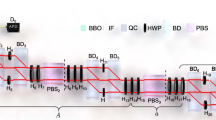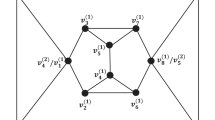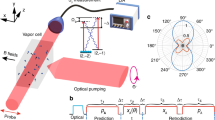Abstract
The question of whether quantum phenomena can be explained by classical models with hidden variables is the subject of a long-lasting debate1,2. In 1964, Bell showed that certain types of classical models cannot explain the quantum mechanical predictions for specific states of distant particles, and some types of hidden variable models3,4,5,6,7,8,9 have been experimentally ruled out. An intuitive feature of classical models is non-contextuality: the property that any measurement has a value independent of other compatible measurements being carried out at the same time. However, a theorem derived by Kochen, Specker and Bell10,11,12 shows that non-contextuality is in conflict with quantum mechanics. The conflict resides in the structure of the theory and is independent of the properties of special states. It has been debated whether the Kochen–Specker theorem could be experimentally tested at all13,14. First tests of quantum contextuality have been proposed only recently, and undertaken with photons15,16 and neutrons17,18. But these tests required the generation of special quantum states and left various loopholes open. Here we perform an experiment with trapped ions that demonstrates a state-independent conflict with non-contextuality. The experiment is not subject to the detection loophole and we show that, despite imperfections and possible measurement disturbances, our results cannot be explained in non-contextual terms.
This is a preview of subscription content, access via your institution
Access options
Subscribe to this journal
Receive 51 print issues and online access
$199.00 per year
only $3.90 per issue
Buy this article
- Purchase on Springer Link
- Instant access to full article PDF
Prices may be subject to local taxes which are calculated during checkout




Similar content being viewed by others
References
Einstein, A., Podolsky, B. & Rosen, N. Can quantum-mechanical description of physical reality be considered complete? Phys. Rev. 47, 777–780 (1935)
Bell, J. S. On the Einstein-Podolsky-Rosen paradox. Physics 1, 195–200 (1964)
Aspect, A., Dalibard, J. & Roger, G. Experimental test of Bell's inequalities using time-varying analyzers. Phys. Rev. Lett. 49, 1804–1807 (1982)
Tittel, W., Brendel, J., Zbinden, H. & Gisin, N. Violation of Bell inequalities by photons more than 10 km apart. Phys. Rev. Lett. 81, 3563–3566 (1998)
Weihs, G., Jennewein, T., Simon, C., Weinfurter, H. & Zeilinger, A. Violation of Bell's inequality under strict Einstein locality conditions. Phys. Rev. Lett. 81, 5039–5043 (1998)
Rowe, M. A. et al. Experimental violation of a Bell's inequality with efficient detection. Nature 409, 791–794 (2001)
Gröblacher, S. et al. An experimental test of non-local realism. Nature 446, 871–875 (2007)
Branciard, C. et al. Testing quantum correlations versus single-particle properties within Leggett's model and beyond. Nature Phys. 4, 681–685 (2008)
Matsukevich, D. N., Maunz, P., Moehring, D. L., Olmschenk, S. & Monroe, C. Bell inequality violation with two remote atomic qubits. Phys. Rev. Lett. 100, 150404 (2008)
Specker, E. Die Logik nicht gleichzeitig entscheidbarer Aussagen. Dialectica 14, 239–246 (1960)
Bell, J. S. On the problem of hidden variables in quantum mechanics. Rev. Mod. Phys. 38, 447–452 (1966)
Kochen, S. & Specker, E. P. The problem of hidden variables in quantum mechanics. J. Math. Mech. 17, 59–87 (1967)
Cabello, A. & García-Alcaine, G. Proposed experimental tests of the Bell-Kochen-Specker theorem. Phys. Rev. Lett. 80, 1797–1799 (1998)
Meyer, D. A. Finite precision measurement nullifies the Kochen-Specker theorem. Phys. Rev. Lett. 83, 3751–3754 (1999)
Michler, M., Weinfurter, H. & Żukowski, M. Experiments towards falsification of noncontextual hidden variable theories. Phys. Rev. Lett. 84, 5457–5461 (2000)
Huang, Y.-F., Li, C.-F., Zhang, Y.-S., Pan, J.-W. & Guo, G.-C. Experimental test of the Kochen-Specker theorem with single photons. Phys. Rev. Lett. 90, 250401 (2003)
Hasegawa, Y., Loidl, R., Badurek, G., Baron, M. & Rauch, H. Quantum contextuality in a single-neutron optical experiment. Phys. Rev. Lett. 97, 230401 (2006)
Bartosik, H. et al. Experimental test of quantum contextuality in neutron interferometry. Preprint at 〈http://arXiv.org/abs/0904.4576〉 (2009)
Peres, A. Incompatible results of quantum measurements. Phys. Lett. A 151, 107–108 (1990)
Mermin, N. D. Simple unified form for the major no-hidden-variables theorems. Phys. Rev. Lett. 65, 3373–3376 (1990)
Cabello, A. Experimentally testable state-independent quantum contextuality. Phys. Rev. Lett. 101, 210401 (2008)
Häffner, H., Roos, C. F. & Blatt, R. Quantum computing with trapped ions. Phys. Rep. 469, 155–203 (2008)
Kirchmair, G. et al. Deterministic entanglement of ions in thermal states of motion. N. J. Phys. 11, 023002 (2009)
Mølmer, K. & Sørensen, A. Multiparticle entanglement of hot trapped ions. Phys. Rev. Lett. 82, 1835–1838 (1999)
Benhelm, J., Kirchmair, G., Roos, C. F. & Blatt, R. Towards fault-tolerant quantum computing with trapped ions. Nature Phys. 4, 463–466 (2008)
Nebendahl, V., Häffner, H. & Roos, C. F. Optimal control of entangling operations for trapped-ion quantum computing. Phys. Rev. A 79, 012312 (2009)
Bechmann-Pasquinucci, H. & Peres, A. Quantum cryptography with 3-state systems. Phys. Rev. Lett. 85, 3313–3316 (2000)
Galvão, E. F. Foundations of Quantum Theory and Quantum Information Applications. Ph.D. thesis, Oxford Univ. (2002)
Spekkens, R. W., Buzacott, D. H., Keehn, A. J., Toner, B. & Pryde, G. J. Preparation contextuality powers parity-oblivious multiplexing. Phys. Rev. Lett. 102, 010401 (2009)
Roos, C. F. et al. Control and measurement of three-qubit entangled states. Science 304, 1478–1480 (2004)
Acknowledgements
We acknowledge support by the Austrian Science Fund (FWF), by the European Commission (SCALA, OLAQUI and QICS networks, and the Marie-Curie programme), by the Institut für Quanteninformation GmbH, by the Spanish MCI Project FIS2008-05596 and the Junta de Andalucía Excellence Project P06-FQM-02243. This material is based on work supported in part by IARPA.
Author Contributions G.K., F.Z. and R.G. performed the experiment and partially analysed the data; M.K., O.G. and A.C. provided the theoretical part and the modelling of imperfect measurements; C.F.R. conceived the experiment and analysed the data; R.B., G.K., F.Z., R.G. and C.F.R. contributed to the experimental set-up; and all authors co-wrote the paper.
Author information
Authors and Affiliations
Corresponding author
Supplementary information
Supplementary Table
This file contains Supplementary Table 1. (PDF 47 kb)
Rights and permissions
About this article
Cite this article
Kirchmair, G., Zähringer, F., Gerritsma, R. et al. State-independent experimental test of quantum contextuality. Nature 460, 494–497 (2009). https://doi.org/10.1038/nature08172
Received:
Accepted:
Issue Date:
DOI: https://doi.org/10.1038/nature08172
This article is cited by
-
Self-testing of a single quantum system from theory to experiment
npj Quantum Information (2023)
-
Quantum Uncertainty Dynamics
Foundations of Physics (2023)
-
Sequential Measurements and the Kochen–Specker Arguments
Journal for General Philosophy of Science (2023)
-
Three-qubit-embedded split Cayley hexagon is contextuality sensitive
Scientific Reports (2022)
-
Quantifying dynamical total coherence in a resource non-increasing framework
Quantum Information Processing (2022)
Comments
By submitting a comment you agree to abide by our Terms and Community Guidelines. If you find something abusive or that does not comply with our terms or guidelines please flag it as inappropriate.



